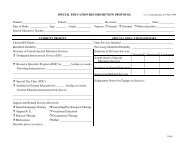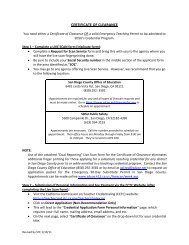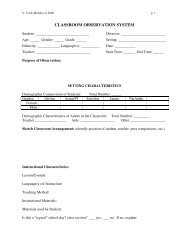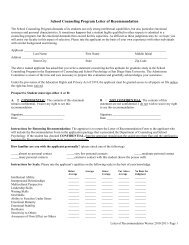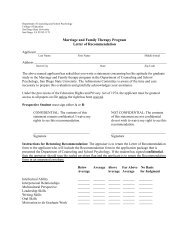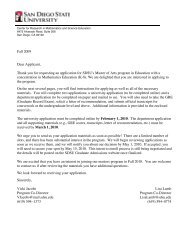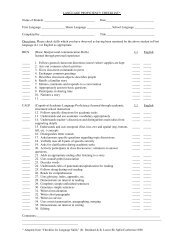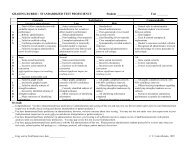Highlights of the Woodcock Johnson III- Diagnostic Supplement ...
Highlights of the Woodcock Johnson III- Diagnostic Supplement ...
Highlights of the Woodcock Johnson III- Diagnostic Supplement ...
You also want an ePaper? Increase the reach of your titles
YUMPU automatically turns print PDFs into web optimized ePapers that Google loves.
Test 31 Bilingual VerbalComprehensionThinking AbilitiesComprehension-Knowledge(Gc)Lexical Knowledge &Language DevelopmentTest 3: Spatial Relations Visual-Spatial Thinking (Gv)Visualization & SpatialRelationsTest 5: Concept Formation Fluid Reasoning (Gf) InductionTest 21: Memory for Names Long-Term Retrieval (Glr) Associative MemoryTest 23: Sound Patterns—Voice (A)Auditory Processing (Ga) Sound DiscriminationCognitive EfficiencyTest 6: Visual Matching (T) Processing Speed (Gs) Perceptual SpeedTest 7: Numbers Reversed (A) Short-Term Memory (Gsm) Working MemoryThe GIA-Bil scale includes six tests that utilize a language-reduced test format. Additionally, forEnglish-Spanish bilingual subjects, <strong>the</strong> GIA-Bil measures four aspects <strong>of</strong> verbal ability using abilingual assessment procedure. This combination <strong>of</strong> language-reduced tests and bilingualtesting <strong>of</strong> verbal ability allows <strong>the</strong> examiner <strong>the</strong> opportunity to explore relative strengths andweaknesses among <strong>the</strong> verbal ability, thinking ability, and cognitive efficiency capabilities <strong>of</strong>bilingual individuals.Verbal Ability. Test 1: Verbal Comprehension includes four subtests that measure verbalability, or <strong>the</strong> CHC broad ability <strong>of</strong> comprehension-knowledge (Gc). The test is administered inEnglish. Items answered incorrectly on Test 1 can be subsequently administered in Spanishusing Test 31: Bilingual Verbal Comprehension. This procedure provides a measure <strong>of</strong> verbalcomprehension in English and Spanish combined. This score is used in calculation <strong>of</strong> <strong>the</strong> GIA-Bil score.Alternatively, examiners can utilize <strong>the</strong> Bilingual Verbal Ability Tess (BVAT) to obtain a measure<strong>of</strong> bilingual verbal comprehension in several o<strong>the</strong>r languages for English-dominant bilingualindividuals. The BVAT includes a more expansive set <strong>of</strong> verbal ability tests in English, withtranslations in Arabic, Chinese (Traditional and Simplified), French, German, Haitian-Creole,Hindi, Hmong, Italian, Japanese, Korean, Navajo, Polish, Portuguese, Russian, Spanish,Turkish, and Vietnamese. When included, <strong>the</strong> BVAT score serves as <strong>the</strong> measure <strong>of</strong> verbalcomprehension in <strong>the</strong> GIA-Bil scale.Thinking Ability. The four thinking ability tests included in <strong>the</strong> GIA-Bil scale were selected forinclusion because (a) <strong>the</strong> language requirements for each test are relatively low when comparedto o<strong>the</strong>r alternatives for assessing <strong>the</strong> same broad CHC ability and (b) each test wasappropriate for use with young children. That is, <strong>the</strong> language used in <strong>the</strong> test directions is at asufficiently low level <strong>of</strong> abstraction that young, English-dominant bilingual individuals can beassessed. In some cases, <strong>the</strong> test’s sample items, controlled feedback, and query proceduresassist <strong>the</strong> examiner in ascertaining <strong>the</strong> subject’s understanding. The following descriptionsdemonstrate <strong>the</strong> appropriateness <strong>of</strong> <strong>the</strong>se tests as measures <strong>of</strong> thinking abilities for bilingualindividuals.





